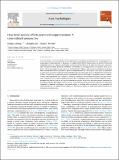Files in this item
How head posture affects perceived cooperativeness : a cross-cultural perspective
Item metadata
| dc.contributor.author | Zhang, Dongyu | |
| dc.contributor.author | Lin, Hongfei | |
| dc.contributor.author | Perrett, David I. | |
| dc.date.accessioned | 2022-05-16T12:31:19Z | |
| dc.date.available | 2022-05-16T12:31:19Z | |
| dc.date.issued | 2022-07 | |
| dc.identifier | 279614437 | |
| dc.identifier | 09144365-9f1a-4a3b-8ca0-97b2f067f976 | |
| dc.identifier | 85129954149 | |
| dc.identifier | 000804800200012 | |
| dc.identifier.citation | Zhang , D , Lin , H & Perrett , D I 2022 , ' How head posture affects perceived cooperativeness : a cross-cultural perspective ' , Acta Psychologica , vol. 227 , 103602 . https://doi.org/10.1016/j.actpsy.2022.103602 | en |
| dc.identifier.issn | 0001-6918 | |
| dc.identifier.other | RIS: urn:DA52A4EC7C17A9A1B3FFD7D05B9046D9 | |
| dc.identifier.other | ORCID: /0000-0002-6025-0939/work/113399163 | |
| dc.identifier.uri | https://hdl.handle.net/10023/25377 | |
| dc.description | This research was supported by grants from the National Natural Science Foundation of China (No. 62076051). | en |
| dc.description.abstract | Previous research has tested whether culture moderates the relationship between head tilt and perceptions of a cooperation-relevant construct. In this paper, we replicated the effects of head posture on perceived traits and compared Chinese and American participants to explore whether difference in cultural background (collectivist and individualist) affects perceptual attribution. Specifically, we investigated how head posture (level, up or down) affects perceptions of cooperativeness. In Experiment 1, Chinese and American participants rated Asian and Caucasian faces in three postures for perceived cooperativeness on a seven-point Likert scale. In Experiment 2, participants ranked the cooperativeness of the three postures of the same faces. In Experiment 3, participants scrolled through face images and manually manipulated vertical head angle to maximise apparent cooperativeness. We found that for both Chinese and American participants a neutral head level posture was perceived as more cooperative than head up and down postures. The optimal head posture for maximised apparent cooperativeness was close to level but with a slight downward rotation. While there was cross-cultural consistency in perceptions, Chinese participants exhibited greater sensitivity to postural cues in their judgments of cooperation compared to American participants. Our results suggest a profound effect of posture on the perception of cooperativeness that is common across cultures and that there are additional subtle cross-cultural differences in the cues to cooperativeness. | |
| dc.format.extent | 7 | |
| dc.format.extent | 1403579 | |
| dc.language.iso | eng | |
| dc.relation.ispartof | Acta Psychologica | en |
| dc.subject | Head posture | en |
| dc.subject | Cooperativeness | en |
| dc.subject | Cross-cultural | en |
| dc.subject | Facial width-to-height ratio | en |
| dc.subject | BF Psychology | en |
| dc.subject | NDAS | en |
| dc.subject.lcc | BF | en |
| dc.title | How head posture affects perceived cooperativeness : a cross-cultural perspective | en |
| dc.type | Journal article | en |
| dc.contributor.institution | University of St Andrews. School of Psychology and Neuroscience | en |
| dc.contributor.institution | University of St Andrews. Institute of Behavioural and Neural Sciences | en |
| dc.contributor.institution | University of St Andrews. Centre for Social Learning & Cognitive Evolution | en |
| dc.identifier.doi | 10.1016/j.actpsy.2022.103602 | |
| dc.description.status | Peer reviewed | en |
| dc.identifier.url | https://www.sciencedirect.com/science/article/pii/S0001691822001172?via%3Dihub#s0105 | en |
This item appears in the following Collection(s)
Items in the St Andrews Research Repository are protected by copyright, with all rights reserved, unless otherwise indicated.

